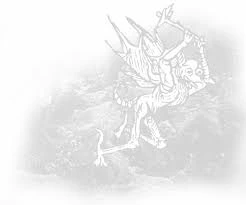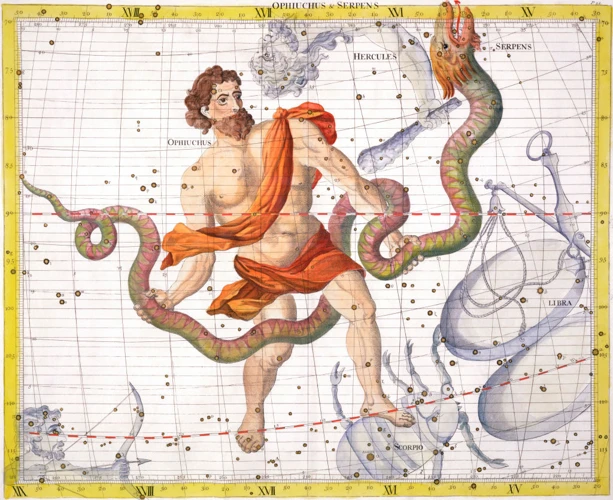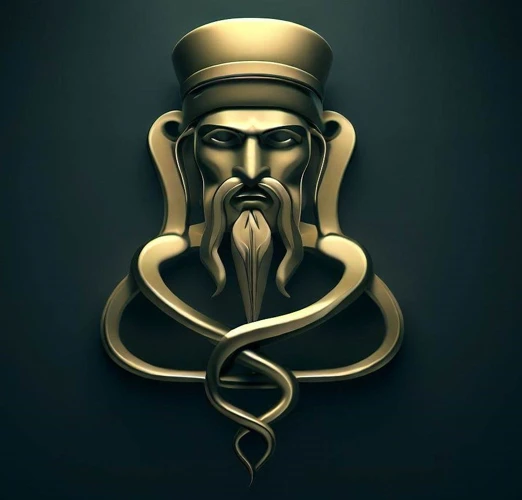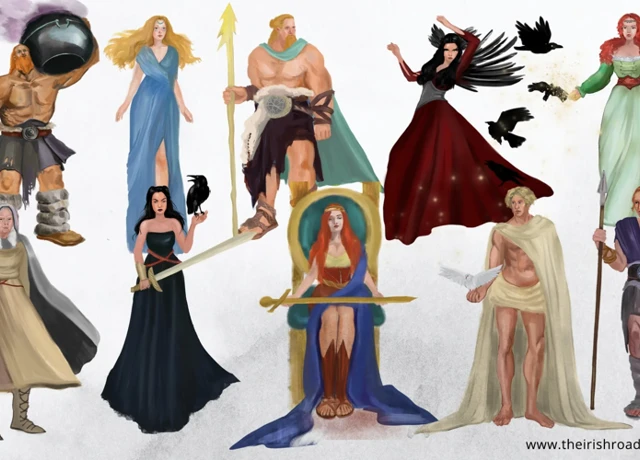Unlocking the Mysteries of Celtic Mythology: A Journey through Deities, Legends, and Symbols
Embark on a captivating adventure into the enchanting realm of Celtic mythology, a rich tapestry of ancient stories and beliefs steeped in magic and folklore. In this immersive article, we will delve deep into the fascinating pantheon of Celtic deities, exploring their roles and significance in the lives of the ancient Celts. Discover the major and lesser-known gods and goddesses who held sway over nature, hear tales of legendary heroes like Cú Chulainn, and unravel the timeless symbols and themes woven throughout these compelling myths. Join us as we delve into the realms of mystery and uncover the enduring influence of Celtic mythology in today’s world.
Celtic Mythology: An Overview

Celtic mythology stands as a testament to the ancient Celtic civilization’s vibrant and mystical beliefs. With roots stretching back thousands of years, this intricate tapestry of folklore and legends weaves together the stories of gods, goddesses, heroes, and magical creatures. Spanning across various Celtic lands, including Ireland, Scotland, Wales, and Gaul, Celtic mythology served as a means to comprehend the natural and supernatural forces that governed their lives. These myths and tales were passed down through generations – an oral tradition that offered glimpses into a complex spiritual and cultural framework. From the mighty Dagda, the god of the earth and fertility, to the fierce warrior goddess Morrigan, each deity played a distinct role in the cosmic order. Through these captivating stories, the Celts sought to understand the mysteries of the universe and their place within it. To truly grasp the profound depth and intricate nuances of Celtic mythology, we must immerse ourselves in the enchanting tales and legends that have shaped the collective imagination of Celtic societies for millennia. For a more in-depth exploration of Celtic mythology, visit our article on Exploring Celtic Mythology.
The Celtic Pantheon

The Celtic pantheon is a vast and diverse collection of gods and goddesses who played pivotal roles in Celtic mythology. These deities, often associated with specific domains and natural elements, personified various aspects of life and were revered by the Celts. At the heart of the pantheon, we find the major deities, such as the mighty war god, Lugh, known for his skill and prowess in battle, and the goddess Brigid, symbolizing healing, poetry, and craftsmanship. These prominent figures were accompanied by a myriad of lesser deities, each with their own unique powers and responsibilities. For example, the mischievous and elusive Leprechauns were believed to guard pots of gold at the end of the rainbow, while the beautiful and ethereal Tuatha Dé Danann were a powerful race of supernatural beings in Irish mythology. To better understand the vast array of deities within the Celtic pantheon, it is essential to explore the origins and evolution of Celtic mythology.
The Major Deities
- Dagda: Known as the “Good God,” Dagda was one of the most prominent and revered Celtic deities. He symbolized fertility, abundance, and wisdom. Often depicted as a robust figure with a magical cauldron and a club capable of both inflicting death and restoring life, Dagda was associated with the earth, agriculture, and the cycles of life.
- Morrigan: The formidable goddess of war, fate, and sovereignty, the Morrigan was a complex and enigmatic figure in Celtic mythology. She had the ability to shape-shift into different forms and could be seen as a crow or raven on the battlefield. The Morrigan possessed a dual nature, representing both the aspects of life and death, and played a crucial role in determining the outcomes of battles.
- Lugh: Lugh, the god of light, arts, and skills, was revered for his immense talents and wisdom. As a master of many crafts, he was associated with craftsmanship, poetry, and healing. Lugh was often portrayed with a long spear and a radiant golden aura, symbolizing his divine nature and expertise in various domains.
- Brigid: Brigid was a multifaceted goddess associated with fire, fertility, healing, and poetic inspiration. She represented the divine feminine and embodied strength, compassion, and creativity. Brigid had the power to bestow blessings upon individuals and communities, and she was highly venerated as a guardian of hearth and home.
- Cernunnos: The Celtic god of animals, nature, and the underworld, Cernunnos was often depicted as a horned deity closely connected to the wilderness and the cycle of life and death. He symbolized the harmony between humans and the natural world that surrounded them, embodying the primal forces of the wild and the mysteries of the unseen realms.
These major deities of Celtic mythology exemplify the diversity and complexity of the pantheon. Each one played a significant role in the lives and beliefs of the ancient Celts, representing different aspects of nature, power, and human experience. To learn more about Irish mythology and its legends, explore our comprehensive article on Irish Mythology Legends.
The Lesser Deities
- Branwen: The goddess of love and beauty, Branwen was known for her gentle and compassionate nature. She was often associated with healing and was revered as the protector of bards and musicians.
- Arawn: As the ruler of the Otherworld, Arawn commanded great power and wisdom. He was associated with the cycle of life and death and played a vital role in Celtic beliefs surrounding the afterlife.
- Lugh: Considered a major deity by some, Lugh was the god of many skills and talents. He was a master of craftsmanship, magic, and warfare, and was often depicted as a heroic figure who brought about prosperity and victory.
- Manannán mac Lir: The sea god, Manannán mac Lir, was revered as the guardian of the waters and the gateway to the Otherworld. He was believed to have the ability to shape-shift and control the tides, and was often associated with sailors and fishermen.
- Brigid: Brigid was a goddess associated with fertility, healing, and poetry. She was also recognized as the patroness of smiths and crafters. Brigid held great importance in Celtic mythology and was later revered as a Christian saint.
- Cernunnos: Often depicted with antlers or as a man with a stag’s head, Cernunnos was the god of nature, animals, and the wild. He represented the untamed forces of the forest and was associated with abundance and fertility.
- Macha: Macha was a goddess associated with sovereignty, war, and horses. She was often depicted as a powerful and fierce figure who could shape-shift into a mare. Macha played a significant role in Celtic mythology, particularly in the tale of the Ulster Cycle.
Key Themes and Symbols

Celtic mythology is rife with key themes and symbols that illuminate the beliefs and values of this ancient culture. Nature and animals hold immense significance in Celtic mythos, as they are seen as sacred and interconnected with the divine. The Celtic people revered the land, forests, and rivers, believing them to be inhabited by powerful spirits. Animals, such as the stag, bear, and raven, were revered as symbols of strength, wisdom, and magic. Additionally, magic and rituals were integral aspects of Celtic mythology, where druids played a pivotal role as intermediaries between humans and the spiritual realm. The intricately designed Celtic knotwork, with its never-ending interwoven patterns, symbolized the eternal cycle of life, death, and rebirth. The triskele, a three-legged spiral, represented the interconnectedness of earth, sea, and sky. These symbols and themes painted a vivid picture of the Celtic worldview, highlighting their deep reverence for nature, their belief in the mystical, and their connection to the cosmic forces that governed their existence.
Nature and Animals
In Celtic mythology, nature and animals hold a significant place in the intricate tapestry of beliefs and symbolism. The ancient Celts revered the natural world, finding deep spiritual connections with the land, the sea, and the creatures that inhabited them. They believed that every aspect of nature was infused with a divine spirit, making it worthy of reverence and respect. Forests were seen as sacred groves, teeming with mystical energy and inhabited by enchanting beings such as fairies and spirits. The trees themselves were regarded as pillars connecting different realms, acting as gateways to otherworldly realms. Animals were also considered sacred, with certain creatures embodying specific qualities and characteristics. For instance, the salmon, known for its wisdom and knowledge, was associated with the legendary figure of Finn MacCool. The stag symbolized strength and nobility, often appearing in tales of heroic quests. Birds, especially ravens and crows, held a special place in Celtic mythology, with the goddess Morrigan taking the form of a crow. These animals and their symbolism served as channels through which the Celts understood the natural world and its interconnectedness with the spiritual realm. The deep reverence for nature and animals in Celtic mythology continues to inspire modern-day environmentalists and those seeking a deeper connection with the natural world.
Magic and Rituals
Magic and rituals held a central place in Celtic mythology, intertwining the realms of mortals and the divine. The Celts believed in the existence of a magical energy that permeated the world, connecting everything together. This belief shaped their rituals and practices, which served as a means to harness and channel this mystical power. Druids, the wise and revered Celtic priests, were the custodians of this ancient knowledge and acted as mediators between the mortal and spiritual realms. With their deep understanding of the natural world, the druids conducted elaborate ceremonies and performed rituals to invoke the favor of the gods, seek protection, and ensure bountiful harvests. The Celts also believed in the power of sacred sites, such as Stonehenge and Avebury, where rituals and ceremonies were conducted to honor the deities and establish a connection with the divine. These rituals often involved offerings, such as food, drink, or precious objects, which were believed to appease the gods and goddesses. The Celts had a profound belief in the power of incantations, spells, and charms to influence and manipulate the natural forces. This magic was not just limited to the druids but was also practiced by skilled individuals known as “seers” or “wise-women.” By engaging in these mystical practices, the Celts sought protection, guidance, and the fulfillment of their desires. They understood that the world around them was alive with unseen forces and by tapping into the realm of magic, they could shape their own destinies.
Popular Celtic Myths

The realm of Celtic mythology is imbued with an array of captivating and influential myths that have been cherished throughout the ages. One such myth is the legendary tale of Cú Chulainn, an Irish hero of extraordinary strength and courage. Born of divine lineage, Cú Chulainn embarked on numerous heroic exploits, including single-handedly defending Ulster against an invading army. His story is filled with epic battles, tragic love, and the haunting allure of destiny. Another prominent myth is the tale of the Morrigan, a shape-shifting goddess associated with war and fate. Often depicted as a crow or a raven, she plays a pivotal role in many significant events, such as her involvement in the hero Cú Chulainn’s life and her role as a guardian of sovereignty. These popular Celtic myths, among others, display the complexity of Celtic storytelling, blending themes of heroism, fate, and the relationship between mortals and the divine.
The Legend of Cú Chulainn
The legend of Cú Chulainn is one of the most renowned and celebrated tales in Celtic mythology. Cú Chulainn, also known as the Hound of Ulster, was a legendary warrior and hero. Born as Setanta, he possessed exceptional strength and prowess from a young age. His transformation into Cú Chulainn began when he accidentally killed a fierce dog, the guardian of the blacksmith Culann. Determined to make amends, Setanta offered to protect Culann’s home and took on the name Cú Chulainn, meaning “Culann’s Hound.”
Throughout his life, Cú Chulainn embarked on countless heroic adventures. He was known for his incredible combat skills and his loyalty to his people. One of the most famous stories associated with him is the Táin Bó Cúailnge, or the Cattle Raid of Cooley. In this epic tale, Cú Chulainn single-handedly defends Ulster against the forces of Queen Medb of Connacht, who sought to raid the province’s prized bull. Despite being heavily outnumbered, Cú Chulainn displayed extraordinary bravery and skill in battle. He fought with unmatched ferocity, using his signature weapon, the Gáe Bulg, a deadly spear that could only be wielded by him.
However, the legend of Cú Chulainn is not just about his warrior prowess. It also delves into his complex character and the tragic aspects of his life. Cú Chulainn’s loyalty and fierce determination were matched by his uncontrollable battle rage, known as his “ríastrad.” During these frenzied states, he would transform into a terrifying force, decimating his enemies but losing touch with his rational self. This internal struggle adds depth to his character, painting him as a flawed hero with human vulnerabilities.
The legend of Cú Chulainn has left an indelible mark on Celtic mythology, capturing the imagination of generations. His bravery, strength, and complex persona continue to inspire and intrigue to this day. The story of Cú Chulainn reminds us of the enduring power of myth and how these timeless tales reflect universal aspects of the human experience. To explore more fascinating Irish myths and legends, check out our article on Irish Mythology Legends.
The Tale of the Morrigan
In Celtic mythology, the Morrigan is a complex and intriguing goddess associated with war, fate, and sovereignty. Her tale, filled with darkness and mystery, captures the imagination and reveals the intricacies of her character. The Morrigan is often depicted as a shape-shifter, assumed the form of a crow or raven, lurking on battlefields to collect the souls of fallen warriors. As the goddess of war, she was known to offer prophecy and guidance to warriors, influencing the outcome of battles. In some tales, the Morrigan appears as a trio of sisters, with Badb and Macha accompanying her. She possesses a powerful and assertive nature, representing both destruction and rebirth. Throughout Celtic mythology, the Morrigan plays a vital role in pivotal events, such as the Táin Bó Cúailnge, where she neared the hero Cú Chulainn in various disguises, testing his abilities and altering the course of fate. This enigmatic goddess remains a captivating symbol of feminine strength and power, embodying the complexities of war and destiny. For more fascinating insights into Irish mythology and legends, be sure to explore our dedicated article on Irish Mythology and Legends.
Influence of Celtic Mythology

The influence of Celtic mythology extends far beyond the ancient societies that birthed it, leaving an indelible mark on various aspects of culture, art, and literature. One notable area where Celtic mythology has made a lasting impact is in the realm of literature. The rich tapestry of Celtic tales and legends has inspired countless authors and poets throughout history. The works of renowned writers such as J.R.R. Tolkien, who drew inspiration from Celtic folklore for his epic fantasy novels, demonstrate the enduring power of these ancient myths. Additionally, Celtic mythology has seeped into popular culture, with references found in modern-day literature, films, and even video games. The mystical allure and archetypal characters of Celtic mythology continue to captivate audiences across the globe. Celtic symbolism and imagery have found their way into various artistic expressions, from intricate Celtic knotwork designs adorning jewelry and tattoos to the use of Celtic motifs in painting and sculpture. This deep-rooted influence is a testament to the timeless appeal and relevance of Celtic mythology. Indeed, the enduring legacy of Celtic mythology serves as a testament to its enduring power and its ability to resonate with people across different time periods and cultures.
The Revival and Modern Interpretations
The rich tapestry of Celtic mythology has not been confined to the annals of history but continues to thrive in the modern era. The late 19th and early 20th centuries saw a resurgence of interest in Celtic culture and heritage, leading to a revival of Celtic mythology. Scholars, artists, and writers began to rediscover and reinterpret the ancient myths, breathing new life into these timeless tales. One such influential figure was Irish poet and playwright, William Butler Yeats, who drew inspiration from Celtic mythology in his literary works. Yeats, along with other members of the Celtic Revival movement, sought to reconnect with Ireland’s ancient past and reclaim its cultural heritage. This revival also found expression in art, with artists like John Duncan and Margaret Macdonald Mackintosh incorporating Celtic themes and motifs into their works. In more recent times, Celtic mythology has found its place in popular culture, captivating audiences through books, films, and television shows that draw upon its mystical elements. Contemporary interpretations of Celtic mythology often explore themes of nature, magic, and the enduring power of ancient wisdom. This ongoing revival serves as a testament to the enduring legacy and timeless allure of Celtic mythology, ensuring that these enchanting tales continue to captivate and inspire audiences today.
Conclusion
In conclusion, delving into the realms of Celtic mythology allows us to uncover a profound connection to the ancient past and gain a deeper understanding of the beliefs and values of the Celtic people. Through their myths and legends, we encounter a world filled with magical creatures, heroic figures, and powerful deities that mirror the intricacies of human existence. The pantheon of Celtic gods and goddesses reflects the reverence and harmony the Celts maintained with nature and the supernatural. The themes and symbols found within these mythological tales continue to captivate and inspire modern audiences, as they explore the interplay between nature, magic, and the human experience. From the epic legends of Cú Chulainn to the enigmatic stories of the Morrigan, the rich tapestry of Celtic mythology reveals timeless truths and provides a window into a vibrant and enchanting world. As we continue to study and appreciate Celtic mythology, we gain a deeper appreciation for the enduring legacy and influence of these ancient tales. Immerse yourself in Celtic mythology, and let the magic and wonder of this mystical realm transport you to a place where legends come to life.
Frequently Asked Questions
1. What is the origin of Celtic mythology?
Celtic mythology can be traced back to the ancient Celtic tribes that inhabited Europe between 1200 BCE and 400 CE. The Celts developed a rich tradition of myths and legends that reflected their beliefs, rituals, and interactions with the natural world.
2. Were the Celtic gods and goddesses based on real people?
The Celtic gods and goddesses were representations of various aspects of nature, human experiences, and cultural values. While they were not based on specific historical figures, they embodied the ideals, qualities, and characteristics that the Celts revered and aspired to emulate.
3. How did Celtic mythology influence daily life?
Celtic mythology played a significant role in shaping the daily lives of the ancient Celts. It provided explanations for natural phenomena, guided religious practices and rituals, influenced social structures, and offered moral and ethical teachings to the community.
4. Were there any female deities in Celtic mythology?
Absolutely! Celtic mythology featured a diverse array of powerful goddesses who represented fertility, war, sovereignty, and other aspects of life. Notable goddesses include Brigid, associated with healing and poetry, and Danu, the mother of the gods.
5. Did the Celts believe in an afterlife?
Yes, the Celts believed in an afterlife. They envisioned a realm known as the Otherworld, a parallel dimension where gods, spirits, and departed souls resided. It was a place of eternal youth, beauty, and joy.
6. Were there any sacred animals in Celtic mythology?
Absolutely! Animals held great symbolic significance in Celtic mythology. The stag, for example, represented strength and virility, while the salmon symbolized wisdom and knowledge. The Celts believed that these sacred creatures possessed spiritual powers.
7. What is the significance of Celtic knots?
Celtic knots are intricate, interwoven patterns that hold deep symbolism in Celtic culture. They represent the eternal cycle of life, death, and rebirth, as well as the interconnectedness of all things. These mesmerizing designs can be found in artwork, jewelry, and ancient monuments.
8. Are there any similarities between Celtic mythology and other mythological traditions?
Yes, there are some similarities between Celtic mythology and other mythological traditions. For example, the tales of heroic warriors like Cú Chulainn bear resemblances to the epic heroes of ancient Greece. However, Celtic mythology also possesses its own unique cultural and regional characteristics.
9. What role did magic play in Celtic mythology?
Magic held a prominent place in Celtic mythology. Druids, the priests and seers of the Celts, practiced mystical arts and were believed to possess supernatural powers. Magic rituals and spells were performed to communicate with the gods, seek guidance, and influence the natural world.
10. How did Christianity impact Celtic mythology?
With the arrival of Christianity, the influence of Celtic mythology began to wane. Many traditional beliefs and deities were assimilated into Christian practices, resulting in a unique blend of Celtic and Christian traditions. However, remnants of Celtic mythology can still be found in folklore, legends, and cultural celebrations.








